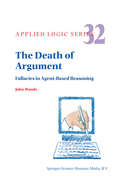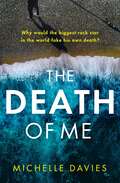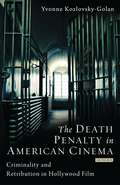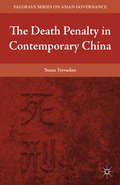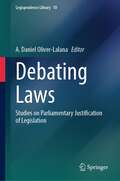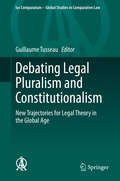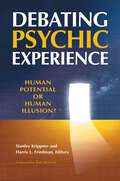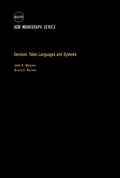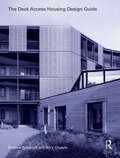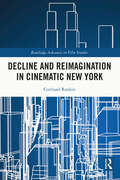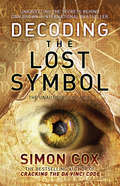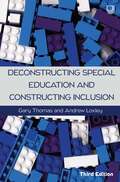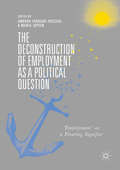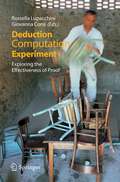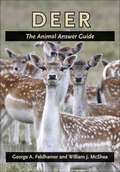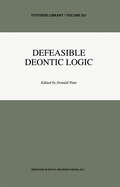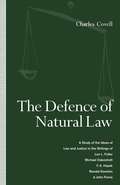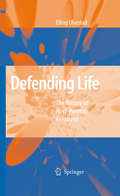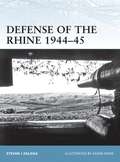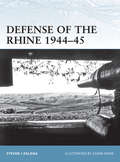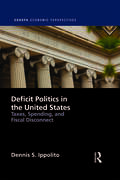- Table View
- List View
The Death of Argument: Fallacies in Agent Based Reasoning (Applied Logic Series #32)
by J.H. WoodsThe present work is a fair record of work I've done on the fallacies and related matters in the fifteen years since 1986. The book may be seen as a sequel to Fallacies: Selected papers 1972-1982, which I wrote with Douglas Walton, and which appeared in 1989 with Foris. This time I am on my own. Douglas Walton has, long since, found his own voice, as the saying has it; and so have I. Both of us greatly value the time we spent performing duets, but we also recognize the attractions of solo work. If I had to characterize the difference that has manifested itself in our later work, I would venture that Walton has strayed more, and I less, from what has come to be called the Woods-Walton Approach to the study of fallacies. Perhaps, on reflection "stray" is not the word for it, inasmuch as Walton's deviation from and my fidelity to the WWA are serious matters of methodological principle. The WWA was always conceived of as a way of handling the analysis of various kinds of fallacious argument or reasoning. It was a response to a particular challenge [Hamblin, 1970]. The challenge was that since logicians had allowed the investigation of fallacious reasoning to fall into disgraceful disarray, it was up to them to put things right. Accordingly, the WWA sought these repairs amidst the rich pluralisms of logic in the 1970s and beyond.
The Death of Me
by Michelle Davies'A twisting tale about the dark undercurrents of fame and fortune. You'll read THE DEATH OF ME with your heart in your mouth.' Erin Kelly Is one of music's greatest mysteries about to be solved?'He was a massive star until he did a headline grabbing retreat from the spotlight - but his disappearing act was FAKED. Fans won't be happy when they find out - his reputation was dead in the water.'When Isaac Naylor committed suicide after a teenage fan was found dead in his hotel room, the world thought it had lost one of the greatest rock stars of a generation. Naylor, lead singer of The Ospreys, had been arrested for causing the girl's death and was on police bail when he drowned himself in the sea off the Devon coast.Now, eight years on, music journalist Natalie Glass stumbles across a blind item on a US gossip website that suggests Naylor's death wasn't quite what it seemed - and he might in fact still be alive.But as she delves deeper into what happened, Natalie finds she has a stark choice: give up trying to find out what happened to Naylor or risk her own obituary ending up in print.
The Death Penalty in American Cinema: Criminality and Retribution in Hollywood Film (Cinema and Society)
by Yvonne Kozlovsky-Golan Yvonne Koslovsky-GolanKilling as punishment in the USA, whether ordained by lynch mob or the courts, reflects a paradox of the American nation: liberal, pluralistic, yet prone to lethal violence. This book examines the encounter between the legal history of the death penalty in America and its cinematic representations, through a comprehensive narrative and historical view of films dealing with this genre, from the silent era to the present. It addresses central issues of, for example, racial prejudice and attitudes towards the execution of women, and discusses how cinema has chosen to deal with them. It explores how such films as Michael Curtiz's 20,000 Years in Sing Sing, Errol Morris' documentary The Thin Blue Line, John Singleton's Rosewood and Frank Darabont's death-row movie The Green Mile, have helped to shape real historical developments and public perceptions by bringing into sharper relief the legal, social, and cultural tensions associated with capital punishment. In the process, it illuminates the complexities of the death penalty through US history.
The Death Penalty in Contemporary China (Palgrave Series in Asian Governance)
by S. TrevaskesChina's infamous death penalty record is the product of firm Party-state control and policy-setting. Though during the 1980s and 1990s, the Party's emphasis was on "kill many," in the 2000s the direction of policy began to move toward "kill fewer." This book details the policies, institutions, and story behind the reform of the death penalty.
Debating Laws: Studies on Parliamentary Justification of Legislation (Legisprudence Library #10)
by A. Daniel Oliver-LalanaThis book seeks to explore the potential and actual value of parliamentary debates as a source of legislative justification. Drawing on a sample of recent Spanish legislation, the papers collected here analyse (critically) the rationale of several laws or legislative measures as it can be reconstructed from the respective parliamentary discussions. All issues covered have given rise to intense political, legal and social controversy: they range from the combat against gender violence, the legal status of bullfighting, the protection of crime victims and the so-called ‘push-backs’ at the border, to the regulation of euthanasia, the minimum living income, underage girls’ access to abortion, and joint child custody. The volume is organised into two main parts. The first group of case studies adopt a legisprudential perspective and examine parliamentary deliberations in the light of the theory and methodology of legislative justification; the contributions in the second part follow approaches that fall outside – but are largely compatible with –legisprudence, and deal with aspects such as the rhetorical strategies employed by MPs when debating bills, and the role of elected legislators as constitutional interpreters.
Debating Legal Pluralism and Constitutionalism: New Trajectories for Legal Theory in the Global Age (Ius Comparatum - Global Studies in Comparative Law #41)
by Guillaume TusseauThe book gathers the general report and the national reports presented at the XXth General Congress of the IACL, in Fukuoka (Japan), on the topic “Debating legal pluralism and constitutionalism: new trajectories for legal theory in the global age”. Discussing the major contemporary changes occurring in and problems faced by domestic legal systems in the global age, the book describes how and to what extent these trends affect domestic legal orderings and practices, and challenges the traditional theoretical lenses that are offered to tackle them: constitutionalism and pluralism. Combining comparative law and comparative legal doctrine, and drawing on the national contributions, the general report concludes that most of the classic tools offered by legal doctrine are not appropriate to address most of today’s practical and theoretical global legal challenges, and as such, the book also offers new intellectual tools for the global age.
Debating Psychic Experience: Human Potential or Human Illusion?
by Stanley Krippner Harris L. FriedmanThis book presents a provocative debate between parapsychological advocates who claim that Western science's worldview is incomplete, and counteradvocates who insist that parapsychological data is either spurious or can be explained by standard scientific principles.Despite ongoing and repeated attempts to prove or disprove the existence of parapsychological events, there are still no conclusive findings—and certainly no consensus across the worldwide community of scholars, scientists, and proponents of psychic phenomena. Still, there is no shortage of information about this fascinating topic to allow everyone to draw their own conclusions.This book has been expressly written to make each chapter and topic accessible to a general audience, despite containing a vast amount of theoretical material. The book is organized into two parts: in the first section, proponents of the validity of parapsychological data and critics who reject that validity state their respective positions. In the second part, each group responds to each others' statements in the form of a debate. Other experts from the United States as well as from Australia and Great Britain provide overviews and conclusions.
Decision Table Languages and Systems
by John R. Metzner Bruce H. BarnesACM Monograph Series: Decision Table Languages and Systems focuses on linguistic examination of decision tables and survey of the features of existing decision table languages and systems. The book first offers information on semiotics, programming language features, and generalization. Discussions focus on semantic broadening, outer language enrichments, generalization of syntax, limitations, implementation improvements, syntactic and semantic features, decision table syntax, semantics of decision table languages, and decision table programming languages. The text then elaborates on design implications, decision structure tables, spectrum of decision table use, and history of decision table programming. Topics include feature evaluation method, breadth of decision table applicability, and suggested design procedure. The book also takes a look at sequential test procedures and language references. The publication is a vital reference for researchers interested in decision table languages and systems.
The Deck Access Housing Design Guide: A Return to Streets in the Sky
by Andrew Beharrell Rory OlcaytoThe Deck Access Housing Design Guide is the first practical design guide to deck access housing. It focuses on the contemporary use of deck access housing, sharing practical guidance and providing in-depth case studies, while also presenting historical context about this flexible and evolving housing type. Despite a chequered history that saw it linked with urban decay and social malaise in the 1970s and 80s, deck access housing today, after a 40-year hiatus, is fast becoming the default solution for mid-rise housing in the UK, and London in particular. This is in part down to architects’ renewed interest in post-war Modernist typologies, but also due to specific planning standards that favour the qualities – dual-aspect plans, ‘public’ front doors – of deck access design. This comprehensive, professional guide spotlights the best contemporary deck access housing in the UK and throughout mainland Europe, explaining and analysing exemplars in detail. Illustrated in full colour throughout with plans, elevations, photographs, project data and annotations, case studies include both new build and retrofit projects, in public housing, co-housing and Third Age residential projects. Good architectural practice flows from an informed understanding of cultural and design history coupled with practical guidance and clear analysis of case studies. That is what this book provides for anyone interested in, or involved in the design and delivery of, deck access housing. Featured architects from the UK: AHMM · Apparata · Cartwright Pickard · Collective Architecture · DO Architecture · Hawkins Brown · Haworth Tompkins · Henley Halebrown · Levitt Bernstein · Maccreanor Lavington · Mæ · Matthew Lloyd · Pitman Tozer · Pollard Thomas Edwards · Proctor & Matthews · PRP · RCKa Featured architects from mainland Europe: ANMA · Arquitectura Produccions · Atelier Kempe Thill · Bureau Massa · DAMAST · Estudio Herreros · Fink + Jocher · KAAN · LEVS · Martin-Löf · MEF · Muñoz Miranda · Passelac & Roques · Waechter + Waechter
The Deck Access Housing Design Guide: A Return to Streets in the Sky
by Andrew Beharrell Rory OlcaytoThe Deck Access Housing Design Guide is the first practical design guide to deck access housing. It focuses on the contemporary use of deck access housing, sharing practical guidance and providing in-depth case studies, while also presenting historical context about this flexible and evolving housing type. Despite a chequered history that saw it linked with urban decay and social malaise in the 1970s and 80s, deck access housing today, after a 40-year hiatus, is fast becoming the default solution for mid-rise housing in the UK, and London in particular. This is in part down to architects’ renewed interest in post-war Modernist typologies, but also due to specific planning standards that favour the qualities – dual-aspect plans, ‘public’ front doors – of deck access design. This comprehensive, professional guide spotlights the best contemporary deck access housing in the UK and throughout mainland Europe, explaining and analysing exemplars in detail. Illustrated in full colour throughout with plans, elevations, photographs, project data and annotations, case studies include both new build and retrofit projects, in public housing, co-housing and Third Age residential projects. Good architectural practice flows from an informed understanding of cultural and design history coupled with practical guidance and clear analysis of case studies. That is what this book provides for anyone interested in, or involved in the design and delivery of, deck access housing. Featured architects from the UK: AHMM · Apparata · Cartwright Pickard · Collective Architecture · DO Architecture · Hawkins Brown · Haworth Tompkins · Henley Halebrown · Levitt Bernstein · Maccreanor Lavington · Mæ · Matthew Lloyd · Pitman Tozer · Pollard Thomas Edwards · Proctor & Matthews · PRP · RCKa Featured architects from mainland Europe: ANMA · Arquitectura Produccions · Atelier Kempe Thill · Bureau Massa · DAMAST · Estudio Herreros · Fink + Jocher · KAAN · LEVS · Martin-Löf · MEF · Muñoz Miranda · Passelac & Roques · Waechter + Waechter
Decline and Reimagination in Cinematic New York (Routledge Advances in Film Studies)
by Cortland RankinDecline and Reimagination in Cinematic New York examines the cinematic representation of New York from the mid-1960s through the mid-1980s, placing the dominant discourse of urban decline in dialogue with marginal perspectives that reimagine the city along alternative paths as a resilient, adaptive, and endlessly inspiring place. Drawing on mainstream, independent, documentary, and experimental films, the book offers a multifaceted account of the power of film to imagine the city’s decline and reimagine its potential. The book analyzes how filmmakers mobilized derelict space and various articulations of “nature” as settings and signifiers that decenter traditional understandings of the city to represent New York alternately as a desolate wasteland, a hostile wilderness, a refuge and playground for outcasts, a home to resilient and resourceful communities, a studio for artistic experimentation, an arcadia conducive to alternative social arrangements, and a complex ecosystem. This book will be of interest to scholars and students of film studies, media studies, urban cinema, urban studies, and eco-cinema.
Decline and Reimagination in Cinematic New York (Routledge Advances in Film Studies)
by Cortland RankinDecline and Reimagination in Cinematic New York examines the cinematic representation of New York from the mid-1960s through the mid-1980s, placing the dominant discourse of urban decline in dialogue with marginal perspectives that reimagine the city along alternative paths as a resilient, adaptive, and endlessly inspiring place. Drawing on mainstream, independent, documentary, and experimental films, the book offers a multifaceted account of the power of film to imagine the city’s decline and reimagine its potential. The book analyzes how filmmakers mobilized derelict space and various articulations of “nature” as settings and signifiers that decenter traditional understandings of the city to represent New York alternately as a desolate wasteland, a hostile wilderness, a refuge and playground for outcasts, a home to resilient and resourceful communities, a studio for artistic experimentation, an arcadia conducive to alternative social arrangements, and a complex ecosystem. This book will be of interest to scholars and students of film studies, media studies, urban cinema, urban studies, and eco-cinema.
Decoding the Lost Symbol: Unravelling the Secrets Behind Dan Brown's International Bestseller: The Unauthorised Guide
by Simon CoxWritten in a clear and concise A to Z format, Decoding the Lost Symbol is the essential guide to the thrilling third Dan Brown novel to feature Harvard symbologist Robert Langdon, The Lost Symbol. Decoding the Lost Symbol takes you on a journey of discovery through the world of Dan Brown and Robert Langdon, opening up the real mysteries and historical facts that are the basis of The Lost Symbol. Set over a breathtaking twelve hours, The Lost Symbol creates a world of intrigue and mystery based around the city of Washington DC. You will discover the amazing truth behind the storyline in Decoding the Lost Symbol, the must-have definitive guide to the Dan Brown novel. Simon Cox is the world-renowned expert on the mysteries of Dan Brown, having already authored the international bestseller Cracking the Da Vinci Code, Illuminating Angels & Demons and The Dan Brown Companion. His guides are essential reading for all fans of the Robert Langdon series of novels and are available in more than fifteen languages.
Deconstructing Special Education and Constructing Inclusion 3e
by Gary Thomas Andrew LoxleyPrevious editions of the bestselling Deconstructing Special Education set a landmark for the understanding of inclusion. This completely re-written third edition continues in the tradition of critical analysis set by the first two editions and assesses how ideas and practice surrounding inclusion adapt to modern pressures and expectations. The new edition addresses: •The influence of intersectionality on the ways we think about special education and inclusion•Contemporary understandings of ‘mental health’ and how these affect the way that we think about behaviour at school•Changing understandings of ‘disability’•The impact of research on the development of inclusion•Marketisation and its corrosive influence on inclusion•The impact of social media on children and young people•How spending on special needs impacts the development of inclusionThe authors address these complex issues in an open and accessible way, making the book essential reading for a broad audience including students, teachers, educational psychologists, policymakers and researchers. “Essential reading for anyone studying or working in either special or inclusive education… Few could build the case as well as Thomas and Loxley.”Melanie Nind, Professor of Education, University of Southampton, UK“Few books in the field of education merit the soubriquet 'must read'. This is one such." Philip Garner, Professor, Brunel University, UK“An absolute must-read for all of us committed to realising genuine inclusion within schools and society!”Jan Valle, The City College of New York, USA"Finishing your first reading of their book makes you realise that you must return to it, such is the richness of the analysis and reach of its detail. This is a tour de force, a line in the sand for all successive work in the field of inclusive education."Roger Slee, Diamond Jubilee Professor of Disability Studies, University of Leeds, UKProfessor Gary Thomas is Emeritus Professor of Inclusion and Diversity at the School of Education, University of Birmingham, UK.Dr Andrew Loxley is an Associate Professor at the School of Education, Trinity College Dublin, Ireland.
The Deconstruction of Employment as a Political Question: 'Employment' as a Floating Signifier
by Amparo Serrano-Pascual Maria JepsenThe wide-ranging European perspectives brought together in this volume aim to analyse, by means of an interdisciplinary approach, the numerous implications of a massive shift in the conception of ‘work’ and the category of ‘worker’. Changes in the production models, economic downturn and increasing digitalisation have triggered a breakdown in the terms and assumptions that previously defined and shaped the notion of employment. This has made it more difficult to discuss, and problematise, issues like vulnerability in employment in such terms as unfairness, inequality and inadequate protection. Taking the ‘deconstruction of employment’ as a central idea for theorising the phenomenon of work today, this volume explores the emergence of new semantic fields and territories for understanding and regulating employment. These new linguistic categories have implications beyond language alone: they reformulate the very concept of waged employment (including those aspects previously considered intrinsic to the meaning of work and of being ‘a worker’), along with other closely associated categories such as unemployment, self-employment, and inactivity.
Deduction, Computation, Experiment: Exploring the Effectiveness of Proof
by Rossella Lupacchini Giovanna CorsiThis volume is located in a cross-disciplinary ?eld bringing together mat- matics, logic, natural science and philosophy. Re?ection on the e?ectiveness of proof brings out a number of questions that have always been latent in the informal understanding of the subject. What makes a symbolic constr- tion signi?cant? What makes an assumption reasonable? What makes a proof reliable? G¨ odel, Church and Turing, in di?erent ways, achieve a deep und- standing of the notion of e?ective calculability involved in the nature of proof. Turing’s work in particular provides a “precise and unquestionably adequate” de?nition of the general notion of a formal system in terms of a machine with a ?nite number of parts. On the other hand, Eugene Wigner refers to the - reasonable e?ectiveness of mathematics in the natural sciences as a miracle. Where should the boundary be traced between mathematical procedures and physical processes? What is the characteristic use of a proof as a com- tation, as opposed to its use as an experiment? What does natural science tell us about the e?ectiveness of proof? What is the role of mathematical proofs in the discovery and validation of empirical theories? The papers collected in this book are intended to search for some answers, to discuss conceptual and logical issues underlying such questions and, perhaps, to call attention to other relevant questions.
Deer: The Animal Answer Guide (The Animal Answer Guides: Q&A for the Curious Naturalist)
by George A. Feldhamer William J. McSheaThink of deer and the image that pops into most American's minds is that of a white-tailed deer, the most common large mammal in North America. Most Europeans are more familiar with red deer. It may surprise many people to know that there are actually about 50 species of deer found throughout the world. Here, readers will find nontechnical, expert information about the wide range of diverse deer species. Did you know that elk and caribou are deer? Or that the earliest fossils of deer are 15 to 20 million years old? Have you ever wondered whether deer swim, play, or see color? How do deer avoid predators and survive the winter? Do deer make good pets or carry contagious diseases? George A. Feldhamer and William J. McShea answer these and other intriguing questions about members of the deer family Cervidae.From the diminutive pudu of South America that weighs 17 pounds to male moose that weigh close to 2,000 pounds, Feldhamer and McShea explore the biology, evolution, ecology, feeding habits, reproduction, and behavior of deer. They chronicle the relationships between humans and deer—both positive and negative—and discuss the challenges of deer conservation and management. With vivid color photographs and an accessible and engaging question-and-answer format, this easy-to-read book is the go-to resource on deer. Nature lovers, hunters, and anyone curious about deer will find this fact-filled book both fascinating and full of surprises.
The Defence of Natural Law: A Study of the Ideas of Law and Justice in the Writings of Lon L. Fuller, Michael Oakeshot, F. A. Hayek, Ronald Dworkin and John Finnis
by Charles CovellThe Defence of Natural Law comprises a study of the philosophies of law expounded by Lon L. Fuller, Michael Oakeshott, F.A. Hayek, Ronald Dworkin and John Finnis. The work of these theorists is situated in relation to the modern tradition in legal philosophy. In this way, it is demonstrated that the theorists adhered closely to the natural law standpoint in legal philosophy, while also defending the particular view of the proper functions of law and the state that distinguished the tradition of modern liberalism.
Defend Your Licence: A Driver's Manual
by Andrea CleggSince founding her business in Road Traffic Defence, experienced lawyer Andrea Clegg has been inundated by clients asking questions about motoring law. Andrea quickly realised how little reliable knowledge and information motorists have available to them about the laws of the road, with many making decisions about whether to accept affixed penalty ticket or a summons based on misconceptions. Defend Your Licence is a practical and helpful guide to motorists, combining accurate law with a clear guide on how to deal with driving related issues should they choose to represent themselves against motoring offence charges. There are many prosecutions which are unjustified and merely accepted by motorists. The system is now prosecuted by the police who in some areas offer advice to the defendant, thus playing the role of prosecutor and defender. Motorists are often poorly guided and represented. As the roads get busier and more regulations are brought in and enforced, the motorist will suffer if they do not improve their legal knowledge. By reading Defend Your Licence motorists everywhere will be better equipped and protected.
Defending Life: The Nature of Host-Parasite Relations
by Elling UlvestadDefending Life discusses the relationship between hosts and parasites. It contains detailed descriptions of the immune system and the microbial world as well as methodological and conceptual clarifications. Its emphasis on analytical abstractions, coherent patterns and generative mechanisms makes possible the distinction between genuine causality and coincidental associations and increases the understanding of why we observe what we observe.
Defense of the Rhine 1944–45 (Fortress)
by Steven J. Zaloga Adam HookThe Rhine River represented the last natural defensive barrier for the Third Reich in the autumn of 1944. Although Hitler had been reluctant to allow the construction of tactical defence lines in France, the final defense of the Reich was another matter. As a result, construction of a Rhine defence line began in September 1944. Steven J. Zaloga examines the multiple phases of construction undertaken to strengthen the Westwall (Siegfried Line), to fortify many of the border villages, and finally to prepare for the demolition of the Rhine bridges. Using detailed maps, colour artwork, and expert analysis, this book takes a detailed look at Germany's last line of defence.
Defense of the Rhine 1944–45 (Fortress #102)
by Steven J. Zaloga Mr Adam HookThe Rhine River represented the last natural defensive barrier for the Third Reich in the autumn of 1944. Although Hitler had been reluctant to allow the construction of tactical defence lines in France, the final defense of the Reich was another matter. As a result, construction of a Rhine defence line began in September 1944. Steven J. Zaloga examines the multiple phases of construction undertaken to strengthen the Westwall (Siegfried Line), to fortify many of the border villages, and finally to prepare for the demolition of the Rhine bridges. Using detailed maps, colour artwork, and expert analysis, this book takes a detailed look at Germany's last line of defence.
Deficit Politics in the United States: Taxes, Spending and Fiscal Disconnect (Europa Economic Perspectives)
by Dennis S IppolitoFrom the clashes between Federalists and Republicans in the 1790s until today, partisan battles over taxing, spending, and public debt have shaped American political development. These battles were formerly constrained by fiscal norms that mandated balanced budgets and low debt. In his Farewell Address, President George Washington counseled the nation to "cherish public credit" by using "it as sparingly as possible". In the 1980s, however, tax cuts and spending increases created large structural deficits and much higher debt levels. With only a brief interruption in the late 1990s, deficit politics has been a mainstay ever since. Over this period, the Republican Party has passed large tax cuts but failed to retrench the large entitlement programs that continue to raise spending. Likewise, the Democratic Party has expanded the domestic role of government but has abandoned the broad-based taxation it supported in the 1990s. Funding their domestic agenda with matching revenues is now as unappealing for Democrats as entitlement cutbacks are for Republicans, contributing to the current stalemate of Republican tax policy, Democratic spending policy, and soaring deficits and debt. The economic risks this entails are serious, yet an end to the era of deficit politics is nowhere in sight.
Deficit Politics in the United States: Taxes, Spending and Fiscal Disconnect (Europa Economic Perspectives)
by Dennis S IppolitoFrom the clashes between Federalists and Republicans in the 1790s until today, partisan battles over taxing, spending, and public debt have shaped American political development. These battles were formerly constrained by fiscal norms that mandated balanced budgets and low debt. In his Farewell Address, President George Washington counseled the nation to "cherish public credit" by using "it as sparingly as possible". In the 1980s, however, tax cuts and spending increases created large structural deficits and much higher debt levels. With only a brief interruption in the late 1990s, deficit politics has been a mainstay ever since. Over this period, the Republican Party has passed large tax cuts but failed to retrench the large entitlement programs that continue to raise spending. Likewise, the Democratic Party has expanded the domestic role of government but has abandoned the broad-based taxation it supported in the 1990s. Funding their domestic agenda with matching revenues is now as unappealing for Democrats as entitlement cutbacks are for Republicans, contributing to the current stalemate of Republican tax policy, Democratic spending policy, and soaring deficits and debt. The economic risks this entails are serious, yet an end to the era of deficit politics is nowhere in sight.
